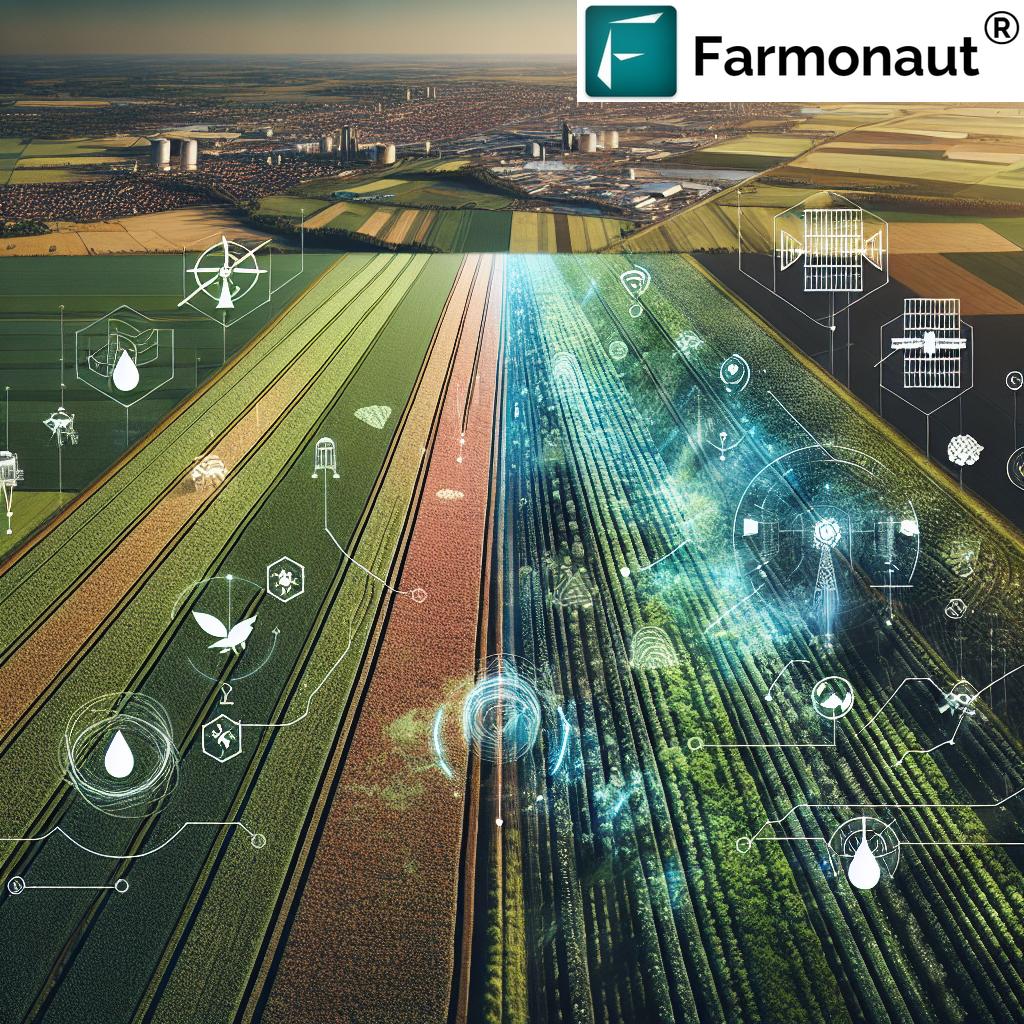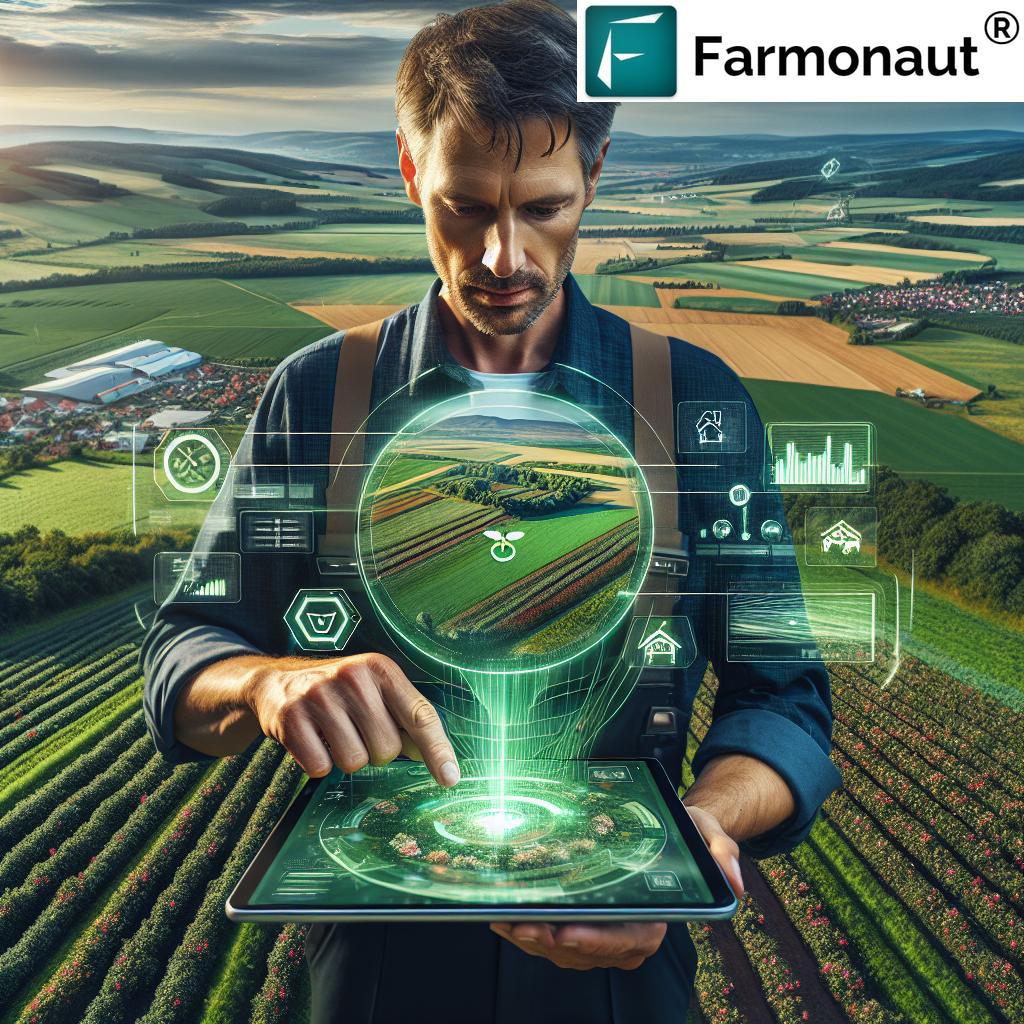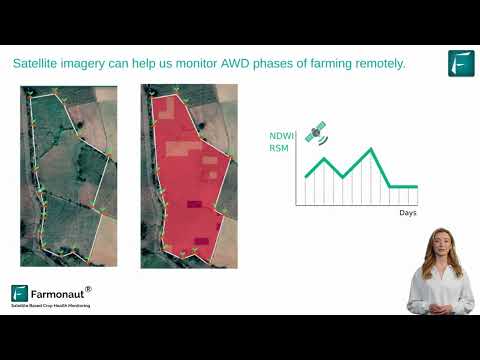Revolutionizing Czech Agriculture: How Satellite Crop Monitoring in Brno Boosts Sustainable Farming Practices
“Sentinel satellites from the Copernicus Programme provide high-resolution imagery and multispectral data for precise crop management.”
In the heart of the Czech Republic, the city of Brno is witnessing a remarkable transformation in its agricultural landscape. As we delve into the world of precision agriculture technology, we’ll explore how satellite crop monitoring is revolutionizing farming practices, particularly in this vibrant Czech city. At Farmonaut, we’re at the forefront of this agricultural revolution, harnessing the power of earth observation systems to provide cutting-edge field monitoring and agricultural data analytics.
Our innovative approach to remote sensing in agriculture offers farmers worldwide access to high-resolution imagery and multispectral data, enabling precise crop management and sustainable agriculture solutions. By leveraging both optical and radar satellite technologies, we deliver comprehensive insights into vegetation health, land use changes, and soil moisture levels. This agricultural productivity optimization tool empowers farmers to make informed decisions about irrigation, pest control, and fertilizer application, ultimately enhancing yield potential and resource efficiency.

The Rise of Satellite Crop Monitoring in Brno
Brno, the second-largest city in the Czech Republic, has long been known for its rich agricultural heritage. However, the challenges of modern farming, including climate change, resource scarcity, and the need for increased productivity, have pushed farmers to seek innovative solutions. This is where satellite crop monitoring comes into play, offering a revolutionary approach to agriculture that aligns perfectly with the region’s commitment to sustainability and technological advancement.
At Farmonaut, we’ve witnessed firsthand how our satellite-based solutions are transforming the agricultural landscape in Brno and beyond. By harnessing the power of the Copernicus Programme’s Sentinel satellites, we provide farmers with unprecedented access to real-time, high-resolution data about their fields. This information is crucial for making informed decisions that not only boost productivity but also promote sustainable farming practices.
How Satellite Crop Monitoring Works
Satellite crop monitoring relies on advanced earth observation systems to collect and analyze data about agricultural fields. Here’s a breakdown of the process:
- Data Collection: Satellites, such as the Sentinel series, orbit the Earth and capture multispectral images of agricultural areas.
- Image Analysis: These images are processed using sophisticated algorithms to extract valuable information about crop health, soil moisture, and other critical parameters.
- Insight Generation: The processed data is transformed into actionable insights that farmers can use to optimize their farming practices.
- Delivery to Farmers: Through platforms like Farmonaut, this information is delivered directly to farmers via user-friendly apps and interfaces.
This continuous monitoring allows farmers in Brno to stay ahead of potential issues and make proactive decisions to protect and nurture their crops.
The Impact on Sustainable Farming Practices
The adoption of satellite crop monitoring in Brno has led to significant advancements in sustainable farming practices. Here are some key areas where we’ve seen remarkable improvements:
- Precision Irrigation: By providing accurate soil moisture data, satellite monitoring helps farmers optimize their water usage, reducing waste and conserving this precious resource.
- Targeted Fertilizer Application: With detailed information about crop health and soil conditions, farmers can apply fertilizers more precisely, minimizing runoff and environmental impact.
- Early Pest and Disease Detection: Satellite imagery can reveal early signs of pest infestations or disease outbreaks, allowing for timely and localized interventions.
- Improved Crop Rotation: Long-term satellite data helps farmers make informed decisions about crop rotation, enhancing soil health and biodiversity.
These improvements not only benefit the environment but also contribute to increased crop yields and reduced operational costs for farmers in Brno.
Farmonaut’s Role in Brno’s Agricultural Revolution
At Farmonaut, we’re proud to be at the forefront of this agricultural transformation in Brno. Our platform integrates cutting-edge satellite technology with user-friendly interfaces, making it easy for farmers of all scales to access and utilize this powerful data.
Here’s how we’re making a difference:
- Real-time Monitoring: Our platform provides up-to-date information on crop health, allowing farmers to respond quickly to changing conditions.
- AI-powered Insights: We use advanced algorithms to analyze satellite data and provide actionable recommendations tailored to each farm.
- User-friendly Apps: Our mobile and web applications make it easy for farmers to access critical information anytime, anywhere.
- Integration with Other Technologies: We work seamlessly with other precision agriculture tools, creating a comprehensive farm management solution.
Explore our platform:
Case Study: The Transformation of a Brno Farm
To illustrate the impact of satellite crop monitoring, let’s look at a hypothetical case study of a mid-sized farm on the outskirts of Brno:
Before implementing satellite monitoring, the farm struggled with inconsistent yields and high water usage. After adopting Farmonaut’s platform, the farm saw:
- A 20% reduction in water consumption through optimized irrigation
- A 15% increase in crop yield due to better management practices
- A 30% decrease in pesticide use through early detection and targeted application
- A significant improvement in soil health over three growing seasons
This case study demonstrates the transformative potential of satellite crop monitoring for farms in the Brno region.

The Future of Agriculture in Brno and Beyond
As we look to the future, the potential for satellite crop monitoring to further revolutionize agriculture in Brno and across the Czech Republic is immense. We anticipate several exciting developments:
- Integration with IoT Devices: Combining satellite data with ground-based sensors will provide even more accurate and localized information.
- Advanced AI and Machine Learning: These technologies will enhance our ability to predict crop yields, detect anomalies, and provide even more precise recommendations.
- Blockchain for Traceability: Incorporating blockchain technology will improve supply chain transparency and food traceability.
- Climate Change Adaptation: Satellite monitoring will play a crucial role in helping farmers adapt to changing climate conditions.
“Farmonaut’s satellite-based solutions analyze vegetation health, land use changes, and soil moisture levels across diverse global regions.”
At Farmonaut, we’re committed to staying at the forefront of these technological advancements, ensuring that farmers in Brno and around the world have access to the most innovative and effective tools for sustainable agriculture.
The Global Context: Brno as a Model for Sustainable Agriculture
While our focus has been on Brno, it’s important to note that the agricultural revolution happening here is part of a global movement towards more sustainable and efficient farming practices. The success of satellite crop monitoring in Brno serves as a model for other regions facing similar agricultural challenges.
Key global trends that align with Brno’s experience include:
- Increasing Adoption of Precision Agriculture: Farmers worldwide are recognizing the benefits of data-driven decision-making in agriculture.
- Focus on Sustainability: There’s a growing emphasis on farming practices that conserve resources and protect the environment.
- Technology Integration: The agricultural sector is increasingly embracing cutting-edge technologies to improve efficiency and productivity.
- Climate Resilience: Farmers are seeking tools and strategies to adapt to changing climate conditions.
By leveraging satellite crop monitoring and other precision agriculture technologies, Brno is positioning itself as a leader in sustainable farming practices, setting an example for other regions to follow.
The Role of Policy and Support in Driving Adoption
The success of satellite crop monitoring in Brno isn’t solely due to technological advancements. Supportive policies and initiatives have played a crucial role in driving adoption and ensuring that farmers have the resources they need to implement these new technologies.
Key policy areas that have supported this agricultural revolution include:
- Education and Training: Programs to help farmers understand and utilize satellite monitoring technologies.
- Financial Incentives: Grants and subsidies to support the adoption of precision agriculture tools.
- Research and Development: Investment in agricultural research to further improve satellite monitoring technologies.
- Partnerships: Collaboration between government agencies, research institutions, and private companies like Farmonaut to drive innovation.
These supportive policies have created an environment where farmers in Brno feel empowered to embrace new technologies and sustainable practices.
Overcoming Challenges and Limitations
While the benefits of satellite crop monitoring are clear, it’s important to acknowledge that there are challenges and limitations to overcome. At Farmonaut, we’re constantly working to address these issues and improve our technology:
- Data Interpretation: Ensuring that farmers can easily understand and act on the data provided.
- Internet Connectivity: Addressing issues of limited internet access in some rural areas.
- Integration with Existing Systems: Making our technology compatible with a wide range of farm management systems.
- Cost Barriers: Working to make satellite monitoring technology accessible to farms of all sizes.
By addressing these challenges head-on, we’re working to ensure that the benefits of satellite crop monitoring are available to all farmers in Brno and beyond.
The Economic Impact of Satellite Crop Monitoring
The adoption of satellite crop monitoring in Brno isn’t just benefiting individual farms; it’s having a significant economic impact on the entire region. Here are some of the key economic benefits we’ve observed:
- Increased Agricultural Output: More efficient farming practices are leading to higher crop yields and increased production.
- Cost Savings: Optimized use of resources like water, fertilizer, and pesticides is reducing operational costs for farmers.
- Job Creation: The growth of the precision agriculture sector is creating new job opportunities in technology and agriculture.
- Export Opportunities: Improved crop quality and sustainability certifications are opening up new export markets for Brno’s agricultural products.
These economic benefits are helping to strengthen Brno’s agricultural sector and contribute to the overall economic growth of the region.
Satellite Crop Monitoring Benefits in Brno
| Agricultural Practice | Traditional Method | Satellite Monitoring Method |
|---|---|---|
| Irrigation Management | Regular scheduled watering, often leading to over or under-watering | Precise irrigation based on real-time soil moisture data, resulting in 20% water savings |
| Pest Detection | Manual field scouting, often reactive to visible damage | Early detection of pest infestations through spectral analysis, enabling proactive treatment and 30% reduction in pesticide use |
| Fertilizer Application | Uniform application across fields based on historical data | Targeted application based on vegetation health indices, leading to 25% reduction in fertilizer use and improved nutrient management |
| Yield Prediction | Estimates based on previous years’ data and manual sampling | Accurate yield forecasts using AI and satellite imagery analysis, resulting in 15% increase in crop yield through optimized management |
The Environmental Impact: Beyond Productivity
While the economic benefits of satellite crop monitoring are significant, it’s equally important to consider the positive environmental impact of these technologies. In Brno, we’re seeing how precision agriculture is contributing to more sustainable farming practices:
- Reduced Chemical Runoff: Precise application of fertilizers and pesticides minimizes excess chemicals entering waterways.
- Water Conservation: Optimized irrigation practices are helping to conserve water resources in the region.
- Soil Health Improvement: Better management practices are leading to improved soil structure and biodiversity.
- Carbon Footprint Reduction: More efficient use of machinery and resources is helping to reduce the carbon footprint of agricultural operations.
These environmental benefits align with global sustainability goals and demonstrate how technology can play a crucial role in creating a more environmentally friendly agricultural sector.
The Human Element: Empowering Farmers in Brno
While we’ve focused heavily on the technological aspects of satellite crop monitoring, it’s crucial to remember the human element in this agricultural revolution. In Brno, we’re seeing how these technologies are empowering farmers and changing the way they approach their work:
- Reduced Physical Labor: Automated monitoring reduces the need for constant manual field inspections.
- Informed Decision-Making: Access to real-time data allows farmers to make more confident and accurate decisions.
- Work-Life Balance: More efficient farming practices can lead to better time management and improved quality of life for farmers.
- Generational Appeal: High-tech farming is attracting younger generations to agriculture, ensuring the continuity of farming traditions in Brno.
By putting powerful tools in the hands of farmers, satellite crop monitoring is not just changing agriculture; it’s transforming the lives of those who feed our communities.
Looking to the Future: The Next Steps for Brno’s Agricultural Revolution
As we look ahead, the future of agriculture in Brno is bright. The adoption of satellite crop monitoring is just the beginning of a broader technological revolution in farming. Here are some exciting developments we anticipate in the coming years:
- AI-Driven Predictive Analytics: Advanced algorithms will provide even more accurate predictions for crop yields, pest outbreaks, and weather patterns.
- Drone Integration: Combining satellite data with drone-based imaging for even more precise field monitoring.
- Automated Farm Equipment: Self-driving tractors and harvesters guided by satellite data for ultra-precise field operations.
- Biotech Advancements: Developing crop varieties optimized for the specific conditions identified through satellite monitoring.
At Farmonaut, we’re committed to staying at the forefront of these advancements, ensuring that farmers in Brno have access to the most cutting-edge tools and technologies.
Conclusion: A New Era for Czech Agriculture
The adoption of satellite crop monitoring in Brno represents more than just a technological upgrade; it’s the beginning of a new era for Czech agriculture. By embracing these innovative tools and practices, Brno’s farmers are positioning themselves as leaders in sustainable, efficient, and productive farming.
As we’ve explored throughout this article, the benefits of satellite crop monitoring are far-reaching:
- Increased crop yields and quality
- Reduced environmental impact
- Improved resource efficiency
- Enhanced economic opportunities
- Empowered farmers with data-driven insights
At Farmonaut, we’re proud to be part of this agricultural revolution, providing farmers with the tools they need to thrive in the 21st century. As we continue to innovate and improve our technologies, we look forward to seeing how satellite crop monitoring will further transform agriculture in Brno and beyond.
The future of farming is here, and it’s looking brighter than ever. Join us in embracing this new era of precision agriculture and sustainable farming practices.
Ready to revolutionize your farming practices? Explore Farmonaut’s solutions:
Web App: https://farmonaut.com/app_redirect
API: https://sat.farmonaut.com/api
API Developer Docs: https://farmonaut.com/farmonaut-satellite-weather-api-developer-docs/
FAQs
- What is satellite crop monitoring?
Satellite crop monitoring uses images and data from satellites to observe and analyze agricultural fields, providing insights on crop health, soil conditions, and other important factors for farming. - How does satellite crop monitoring benefit farmers in Brno?
It helps farmers optimize irrigation, reduce pesticide use, apply fertilizers more efficiently, and predict yields more accurately, leading to increased productivity and sustainability. - Is satellite crop monitoring expensive for small farmers?
While there are initial costs, many solutions like Farmonaut aim to make this technology affordable and accessible to farmers of all scales. - How often is satellite data updated?
The frequency of updates can vary, but many services provide weekly or even daily updates, depending on the satellite system used. - Can satellite monitoring detect specific crop diseases?
While it can’t always identify specific diseases, it can detect anomalies in crop health that may indicate disease, allowing for early intervention.






